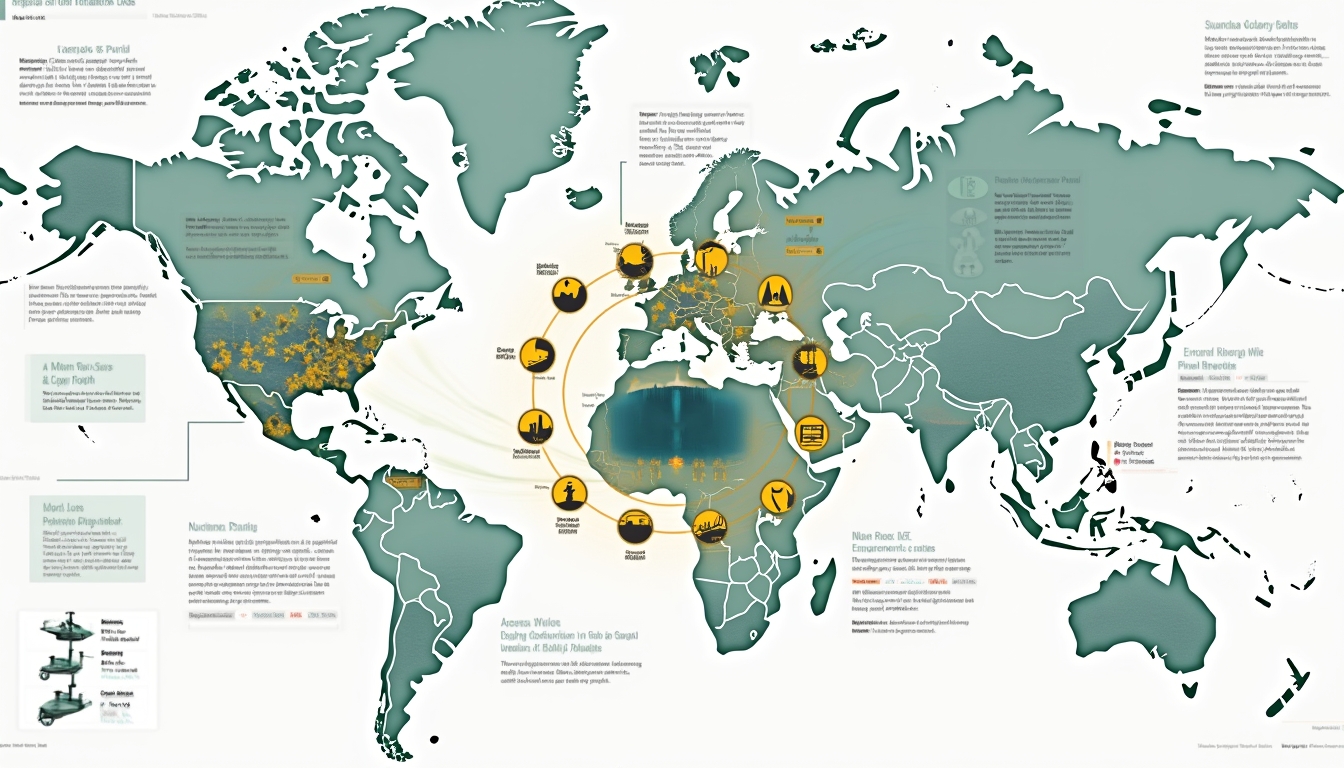Gold soars, energy policy burns in today’s volatile market environment. The Australian resource sector is now facing intense market pressures while traditional energy strategies clash with modern sustainable approaches. Investors and policymakers alike are compelled to re‐examine their positions in this transformative period.
The Explosive State of Australian Energy Policy
Australia’s energy strategy is under significant scrutiny. Industry experts such as Chris Uhlmann highlight deep contradictions in resource management. While Australia remains a major exporter, domestic energy policies can appear poorly aligned with long‐term goals.
Key challenges include renewable energy initiatives that do not properly integrate with classic resource strategies. This dissonance presents risks to long‐term economic resilience. For example, there are critics who question the coherence of domestic policies.
Examinations of these policy gaps have led to discussions about sustainable manufacturing. Initiatives like green aluminium exports have received attention as potential models for innovation.
Recent international reports, including insights from clean energy insights, detail how energy strategies can simultaneously foster growth while promoting environmental goals.
Each challenge calls for a more flexible and future‐oriented policy framework. Such realignment is essential if Australia is to maintain its competitive edge while addressing environmental responsibilities.
Gold's Meteoric Rise: A Safe Haven in Uncertain Times
Gold has seen a remarkable surge, with prices increasing by 40% year‐to‐date. Central banks across the globe are diversifying by increasing allocations in precious metals. Investors have turned to the metal as a safeguard during economic instability.
Global market analyses, including insights on global production trends, suggest that geopolitical tensions and inflation create a conducive environment for rising gold. In this climate, many believe that gold soars, energy policy burns become intertwined phenomena.
Investors show an increasing preference for gold. They consider it a robust hedge against structural economic shocks, given the current uncertainties. The market’s response reflects deep apprehensions about long‐term global stability.
Financial experts also highlight gold investment strategies as a means of capitalising on these trends. Their recommendations underscore the importance of diversifying assets during turbulent economic cycles.
Merger and Acquisition Dynamics in the Mining Sector
Consolidation in the mining sector is rising. Major transactions such as Northern Star’s recent acquisition signal transformative changes. The deal, valued at billions, is a remarkable indicator of shifting industry dynamics.
Exploratory moves by industry giants are reshaping the market landscape. The historic gold deal has set the stage for increased mergers, indicating broader consolidation trends.
Private equity is increasingly active in this space. Their investments reveal a growing confidence in long‐term resource outputs, despite short‐term market volatility. Strategic consolidation is now viewed as vital for realising geological potential.
This shifting environment urges smaller firms to reassess their strategies. Junior mining investments now face additional pressures that call for both agility and innovation.
Regulatory Challenges: The ASX's Compliance Conundrum
The Australian Securities Exchange (ASX) continues to be burdened by extensive regulations. Compliance challenges are causing a downturn in IPO activity, pushing firms toward private funding. These changes signal a new era in the capital markets.
Junior mining sectors feel this strain most acutely. Rising costs and stringent disclosure requirements have reduced opportunities for smaller companies. The market is witnessing a shift towards junior mining investments.
This regulatory pressure may stifle innovation. Industry leaders argue that easing these burdens could stimulate further investment and expand market access. Regulatory reforms remain a critical agenda item for policymakers.
Investors continue to monitor these developments closely. They understand that easing compliance requirements may lead to more robust market growth. Such changes could unlock potential across the sector, providing fresh avenues for capital allocation.
Geopolitical Uncertainty and Economic Outlook
Global power dynamics have never been more volatile. Economic challenges now intersect with political shifts, affecting resource markets. Rising living costs and election‐driven debates further complicate the landscape.
Structural changes in world economies have increased uncertainty. The current sentiment pushes investors toward stable assets, including gold. This environment reinforces the notion that gold soars, energy policy burns as governments struggle to balance domestic needs with export demands.
Key points to consider include:
- Geopolitical instability driving investor sentiment
- Fragile domestic policies amid rapid economic changes
- Increased regulatory scrutiny impacting market dynamics
These elements combine to create a complex backdrop for future investments. The interplay of political, regulatory, and economic factors leads to risk as well as opportunity.
Trade and political alliances also play a significant role. Recent shifts in international relations are influencing resource pricing on multiple fronts, from metals to energy commodities. This delicate balance requires proactive policy adjustments.
The Future of Australian Resources: A Call to Action
Industry leaders are now advocating for a strategic overhaul. A balanced policy framework can address economic and environmental challenges. It is essential for Australia to develop long‐term resource strategies that promote both sustainable growth and secure market positions.
Key recommendations for policymakers include:
- Developing coherent long‐term resource strategies
- Creating flexible regulatory environments
- Encouraging technological innovation
- Promoting sustainable exploration practices
Advocates point out that realigning these strategies is crucial for maintaining competitive advantage. New developments, like the iron ore stimulus, highlight areas where policy can lead to positive change.
Continuous dialogue among industry players, government officials, and investors is vital. Such collaboration can unveil opportunities that have been obscured by past policies. Leaders must embrace forward‐thinking approaches and adapt to evolving market demands.
Investment in technology and infrastructure remains key. Regulatory reforms and increased private funding can lead to innovative exploration techniques. This balanced approach could sustain growth in an otherwise unpredictable market.
Emerging Trends and Investment Opportunities
The current resource outlook is marked by rapid transformations. Investors are increasingly exploring diverse strategies to manage risks. With the prevailing environment of geopolitical uncertainty and market volatility, new trends are emerging.
Evidence suggests that diversification is key. A growing number of companies are diversifying preferences between traditional resources and advancing sustainable technologies. Investors look to make informed, agile decisions.
Opportunities also exist for exploring alternative energy sources. Advancements in renewable energy offer promising returns. By combining insights from both resource-based and renewable sectors, investors can manage uncertainties better.
The strategic mix of traditional and innovative approaches promises to drive growth. Firms must remain adaptable and critically assess market trends. Success lies in the ability to capitalise on emerging opportunities amid evolving policy landscapes.
Industry Perspectives and Future Investment Strategies
Industry experts have noted significant shifts in market dynamics. Gold soars, energy policy burns now frequently describe the state of global markets. Experts stress that a multifaceted approach is needed to address both investment and policy challenges.
As market pressures mount, strategies such as mergers, acquisitions, and diversified portfolios become increasingly relevant. Many investors are moving towards assets perceived as safe havens during economic uncertainty. This trend is further supported by expert analyses in various research reports.
The market’s ongoing evolution requires attention to key investment strategies:
- Incorporating diversification in asset allocation
- Monitoring regulatory changes closely
- Embracing technological innovations for exploration
- Strengthening market fundamentals through sustainable practices
These strategies can ensure that investments remain resilient during periods of economic stress. The intersection where traditional resources and cutting-edge technology meet offers a promising landscape for future growth.
Recent market data reinforces that comprehensive investment analysis is critical. Detailed insights from industry leaders emphasise that bridging gaps between resource sectors is essential. The discussions now revolve around aligning policy with market needs.
Gold soars, energy policy burns is not only a reflection of current market dynamics but also a call for strategic reorientation. As policymakers and industry players navigate this transformation, collaborative reforms and proactive investment strategies will be central to ensuring long‐term economic stability.
Ready to Gain a Market-Leading Edge in Resource Investments?
Discovery Alert's proprietary Discovery IQ model provides instant, real-time notifications on significant ASX mineral discoveries, transforming complex market data into actionable investment insights. Begin your 30-day free trial today and position yourself ahead of the market's dynamic resource landscape.







